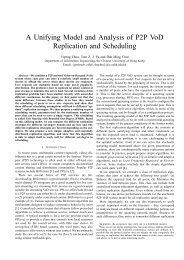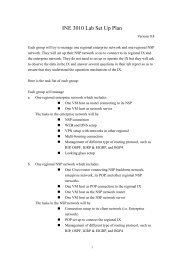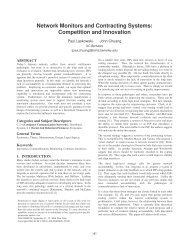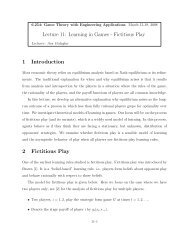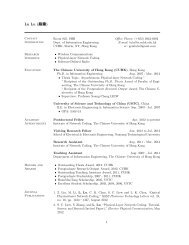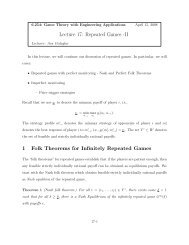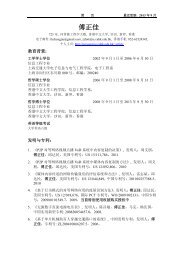Defending Against Distributed Denial-of-service Attacks with Max ...
Defending Against Distributed Denial-of-service Attacks with Max ...
Defending Against Distributed Denial-of-service Attacks with Max ...
You also want an ePaper? Increase the reach of your titles
YUMPU automatically turns print PDFs into web optimized ePapers that Google loves.
1<br />
<strong>Defending</strong> <strong>Against</strong> <strong>Distributed</strong> <strong>Denial</strong>-<strong>of</strong>-<strong>service</strong> <strong>Attacks</strong><br />
<strong>with</strong> <strong>Max</strong>-min Fair Server-centric Router Throttles<br />
David K. Y. Yau John C. S. Lui Feng Liang<br />
Abstract<br />
We present a network architecture and accompanying algorithms for countering<br />
distributed denial-<strong>of</strong>-<strong>service</strong> (DDoS) attacks directed at an Internet<br />
server. The basic mechanism is for a server under stress to install a router<br />
throttle at selected upstream routers. The throttle can be the leaky-bucket rate<br />
at which a router can forward packets destined for the server. Hence, before<br />
aggressive packets can converge to overwhelm the server, participating routers<br />
proactively regulate the contributing packet rates to more moderate levels, thus<br />
forestalling an impending attack. In allocating the server capacity among the<br />
routers, we propose a notion <strong>of</strong> level- max-min fairness. We present a controltheoretic<br />
model to evaluate algorithm convergence under a varitey <strong>of</strong> system<br />
parameters. In addition, we present packet network simulation results using a<br />
realistic global network topology, and various models <strong>of</strong> good user and attacker<br />
distributions and behavior. Using a generator model <strong>of</strong> web requests parameterized<br />
by empirical data, we also evaluate the impact <strong>of</strong> throttling in protecting<br />
user access to a web server. First, for aggressive attackers, the throttle mechanism<br />
is highly effective in preferentially dropping attacker traffic over good user<br />
traffic. In particular, level- max-min fairness gives better good-user protection<br />
than recursive pushback <strong>of</strong> max-min fair rate limits proposed in the literature.<br />
Second, throttling can regulate the experienced server load to below its design<br />
limit – in the presence <strong>of</strong> user dynamics – so that the server can remain operational<br />
during a DDoS attack.<br />
I. Introduction<br />
In a distributed denial-<strong>of</strong>-<strong>service</strong> (DDoS) attack (e.g., [1], [2]), a<br />
cohort <strong>of</strong> malicious or compromised hosts (the “zombies”) coordinate<br />
to send a large volume <strong>of</strong> aggregate traffic to a victim server. In such an<br />
episode, it is likely that network nodes near the edge will progressively<br />
become more vulnerable to resource overruns as their distance from<br />
the server decreases. There are two reasons. First, a node that is closer<br />
to the server will likely have less <strong>service</strong> capacity because it is closer to<br />
the network edge, and is designed to handle fewer users. Second, such<br />
a node will generally see a larger fraction <strong>of</strong> the attack traffic, which<br />
has gone through more aggregation inside the network. In particular,<br />
the server system itself is highly vulnerable, and can become totally<br />
incapacitated under extreme overload conditions.<br />
We view DDoS attacks as a resource management problem. Our<br />
goal in this paper is to protect a server system from having to deal <strong>with</strong><br />
excessive <strong>service</strong> request arrivals over a global network. (However, the<br />
approach can be easily generalized to protecting an intermediate routing<br />
point under overload.) To do so, we adopt a proactive approach:<br />
Before aggressive packets can converge to overwhelm a server, we ask<br />
routers along forwarding paths to regulate the contributing packet rates<br />
to more moderate levels, thus forestalling an impending attack. The<br />
basic mechanism is for a server under stress, say ¡ , to install a router<br />
throttle at an upstream router several hops away. The throttle limits the<br />
D. Yau and F. Liang are <strong>with</strong> the Department <strong>of</strong> Computer Sciences, Purdue<br />
University, West Lafayette, IN 47907 (D. Yau supported in part by the<br />
National Science Foundation under grant number EIA-9806741 and CAREER<br />
grant number CCR-9875742, and in part by CERIAS; F. Liang supported in part<br />
by CERIAS). J. Lui is <strong>with</strong> the Department <strong>of</strong> Computer Science and Engineering,<br />
Chinese University <strong>of</strong> Hong Kong, Shatin, Hong Kong (J. Lui supported in<br />
part by RGC Earmarked Grant). Contact author: D. Yau (yau@cs.purdue.edu).<br />
rate at which packets destined ¡ for will be forwarded by the router.<br />
Traffic that exceeds the rate limit can either be dropped or rerouted to<br />
an alternate server, although we will focus exclusively on the dropping<br />
solution in this paper.<br />
A key element in the proposed defense system is to install appropriate<br />
throttling rates at the distributed routing points, such that, globally,<br />
exports its full <strong>service</strong> capacity ¢¤£ to the network, but no more.<br />
¡<br />
The “appropriate” throttles should depend on the current demand distributions,<br />
and so must be negotiated dynamically between server and<br />
network. Our negotiation approach is server-initiated. A server operating<br />
below the designed load limit needs no protection, and need not<br />
install any router throttles. As server load increases and crosses the<br />
designed load ¢¥£ limit , however, the server may start to protect itself<br />
by installing and activating a rate throttle at a subset <strong>of</strong> its upstream<br />
routers. After that, if the current throttle fails to bring down the load<br />
¡ at to ¢¤£ below , then the throttle rate is reduced 1 . On the other hand,<br />
if the server load falls below a low-water ¦ £ mark ¦ £¨§ ¢ £ (where ),<br />
then the throttle rate is increased (i.e., relaxed). If an increase does not<br />
cause the load to significantly increase over some observation period,<br />
then the throttle is removed. The goal <strong>of</strong> the control algorithm is to<br />
keep the server load © ¦£¢¤£ <strong>with</strong>in whenever a throttle is in effect.<br />
Router throttling has been implemented on the CROSS/Linux s<strong>of</strong>tware<br />
router running on a Pentium III/864 MHz machine. Because <strong>of</strong><br />
limited space, we are not able to discuss our implementation in this<br />
paper, but refer the reader to [6] for the details. However, our implementation<br />
results indicate that (i) since throttling requires only looking<br />
up the IP destination address <strong>of</strong> a packet, it has essentially the same<br />
processing complexity as standard IP forwarding, and adds little computational<br />
overhead at a deployment router, and (ii) the amount <strong>of</strong> state<br />
information a router has to keep per throttle is a few bytes, for storing<br />
the destination IP address and the throttle value. Although throttling is<br />
space-efficient, the total amount <strong>of</strong> state information needed at a router<br />
is nevertheless linear in the number <strong>of</strong> installed throttles. Hence, it<br />
may not be possible for the routers to maintain state about every Internet<br />
server. However, the approach can be feasible as an on-demand<br />
and selective protection mechanism. The premise is that DDoS attacks<br />
are the exception rather than the norm. At any given time, we<br />
expect at most only a minor portion <strong>of</strong> the network to be under attack,<br />
while the majority remaining portion to be operating in “good health”.<br />
Moreover, rogue attackers usually target “premium sites” <strong>with</strong> heavy<br />
customer utilization, presumably to cause maximal user disruptions<br />
and to generate the most publicity. These selected sites may then elect<br />
to protect themselves in the proposed architecture, possibly by paying<br />
for the <strong>of</strong>fered <strong>service</strong>s.<br />
A. Our contributions<br />
Our contributions in this paper are:<br />
We contribute to the fundamental understanding <strong>of</strong> router throttling<br />
as a mechanism against DDoS attacks. In particular, we advance<br />
a control-theoretic model useful for understanding system<br />
behavior under a variety <strong>of</strong> parameters and operating conditions.<br />
Notice that reducing the throttle rate increases the extent <strong>of</strong> throttling, because<br />
a router will more restrict traffic destined for .
2<br />
We present an adaptive throttle algorithm that can effectively protect<br />
a server from resource overload, and increase the ability <strong>of</strong><br />
good user traffic to arrive at the intended server.<br />
We show how max-min fairness can be achieved across a potentially<br />
large number <strong>of</strong> flows, and the implication <strong>of</strong> a notion <strong>of</strong><br />
level- max-min fairness on DDoS attacks.<br />
We study how throttling may impact real application performance.<br />
Specifically, we demonstrate via simulations the performance<br />
impact on an HTTP web server.<br />
59.9<br />
S<br />
24.88<br />
0.22<br />
15.51<br />
17.73<br />
18.23<br />
a<br />
0.22<br />
g<br />
1.40<br />
g<br />
6.65<br />
a<br />
14.10<br />
a<br />
0.01<br />
g<br />
B. Paper organization<br />
The balance <strong>of</strong> the paper is organized as follows. In Section II, we<br />
introduce our system model. In Section III, we formally specify a baseline<br />
and a fair algorithm for computing throttle rates. In Section IV,<br />
we present a control-theoretic mathematical model for understanding<br />
system performance under a variety <strong>of</strong> parameters and operating conditions.<br />
To further examine system performance under detailed packet<br />
network models, Section V presents diverse ns2 simulation results using<br />
a realistic network topology. In Section VI, we discuss several issues<br />
about the practical deployment <strong>of</strong> our solution. Section VII compares<br />
our solution approach <strong>with</strong> related work in the literature. Section<br />
VIII concludes.<br />
II. System Model<br />
We begin by stating Convention 1 that simplifies our presentation<br />
throughout the rest <strong>of</strong> the paper. Then, we go on to describe our system<br />
model.<br />
Convention 1: All traffic rate and server load quantities stated<br />
in this paper are in units <strong>of</strong> kb/s, unless otherwise stated.<br />
We model a network as a connected ¡£¢¥¤§¦¤©¨ graph , ¦ where is<br />
the set <strong>of</strong> nodes ¨ and is the set <strong>of</strong> edges. All leaf nodes are hosts and<br />
thus can be a traffic source. An internal node is a router; a router cannot<br />
generate traffic, but can forward traffic received from its connected<br />
hosts or peer routers. We denote by the set <strong>of</strong> internal routing nodes.<br />
All routers are assumed to be trusted. The set <strong>of</strong> ¢¦ hosts, ,<br />
is partitioned into the set <strong>of</strong> ordinary “good” users, , and the set <strong>of</strong><br />
attackers ¨ . models the network links, which are assumed to be<br />
bi-directional. Since our goal is to investigate control against server<br />
resource overload, each link is assumed to have infinite bandwidth.<br />
The assumption can be relaxed if the control algorithm is also deployed<br />
to protect routers from overload.<br />
In our study, we designate a leaf node ¦ in as the target ¡ server .<br />
A good user sends packets ¡ to at some rate chosen from the range<br />
© . An attacker sends packets to ¡ at some rate chosen from the<br />
©<br />
© © range . In principle, while can usually be set to a reasonable<br />
level according to how users normally access the <strong>service</strong> ¡ at (and we<br />
¢¥£ assume ), it is hard to prescribe constraints on the choice <strong>of</strong><br />
. In practice, it is reasonable to assume that is significantly higher<br />
<br />
than . This is because if every attacker sends at a rate comparable<br />
to a good user, then an attacker must recruit or compromise a large<br />
number <strong>of</strong> hosts to launch an attack <strong>with</strong> sufficient traffic volume.<br />
¡ When is under attack, it initiates the throttle defense mechanism<br />
outlined in Section I. (For ease <strong>of</strong> presentation, we assume that<br />
an overloaded server is still capable <strong>of</strong> initiating the defense actions.<br />
However, as discussed in Section VI, the assumption can be relaxed<br />
in practice.) The throttle does not have to be deployed at every router<br />
in the network. Instead, the deployment points are parameterized by<br />
a positive integer and are given by ¤ . Specifically, ¤ <br />
contains all the routers that are either hops away ¡ from or less than<br />
hops away ¡ from but are directly connected to a host.<br />
Fig. 1 shows an example network topology. In the figure, a square<br />
node represents a host, while a round node represents a router. The host<br />
S<br />
g<br />
server<br />
good user<br />
router<br />
a<br />
attacker<br />
0.95<br />
router in R(3)<br />
0.61<br />
0.95<br />
g<br />
17.73<br />
a<br />
0.61<br />
g<br />
Fig. 1. Network topology "!$#&% illustrating deployment points <strong>of</strong> router throttle,<br />
and <strong>of</strong>fered traffic rates.<br />
on the far left is the target server ¡ . The routers in ¤'( are shaded<br />
in the figure. Notice that the bottom-most router in )¤'* is only two<br />
hops away from ¡ , but is included because it is directly connected to a<br />
host.<br />
Given our system model, an important research problem is how to<br />
achieve fair rate allocation <strong>of</strong> the server capacity among the routers in<br />
)¤ . To that end, we define the following notion <strong>of</strong> level- max-min<br />
fairness:<br />
Definition 1—level- max-min fairness: A resource control algorithm<br />
achieves level- max-min fairness among the routers ¤ ,<br />
if the allowed forwarding rate <strong>of</strong> traffic for ¡<br />
at each router is the<br />
router’s max-min fair share <strong>of</strong> some rate satisfying ¦ £,+-)+ ¢¥£ .<br />
A. Baseline algorithm<br />
III. Throttle Algorithms<br />
We present a baseline algorithm in which each router throttles traffic<br />
¡ for by forwarding only a . (/+0.1+¥2 fraction ) <strong>of</strong> the traffic. The<br />
. fraction is taken to be one when no throttle ¡ for is in effect. In adjusting<br />
according to current server congestion, the algorithm mimics<br />
.<br />
TCP congestion control. . Specifically, is reduced by a multiplicative<br />
3 factor ¡ when is congested and sends the router a rate reduction signal.<br />
It is increased by an additive 4 constant – subject to the condition<br />
.0+52 that – ¡ when has extra capacity and sends the router a rate<br />
increase signal.<br />
The baseline algorithm ¡ that runs is specified in Fig. 2. It is to<br />
be invoked when either (i) the current server load (measured as traffic<br />
arrival rate ¡ to ) ¢ £ crosses , or (ii) a throttle is in effect and the current<br />
server load drops ¦£ below . In case ¡ (i), multicasts a rate reduction<br />
signal to ¤ ; in case (ii), it multicasts a rate increase signal. The<br />
algorithm can take multiple rounds until a server load © ¦ £ ¢ £ <br />
<strong>with</strong>in<br />
is achieved. Also, if the server load is ¦ £ below , and the next rate<br />
increase signal raises the server load by an insignificant amount (i.e.,<br />
by less than 6 ), we remove the throttle. The monitoring window 7<br />
should be set to be somewhat larger than the maximum round trip time<br />
between ¡ and a router in ¤ .<br />
In the example network shown in Fig. 1, let the number above each<br />
host (except ¡ ) denote the current rate at which the host sends traffic<br />
to ¡ . The number above each router denotes the <strong>of</strong>fered rate <strong>of</strong> traffic<br />
at the router, destined for ¡ . Also, let ¦ £8¢92;: , ¢¥£8¢=< ,<br />
and 4@¢ACB *D . Initially, the total <strong>of</strong>fered load to ¡ exceeds ¢ £ , and<br />
hence the baseline throttle algorithm is invoked at ¡ . A rate reduction
3<br />
Algorithm baseline throttle<br />
last ¡£¢ := ;<br />
while (1)<br />
monitor traffic arrival rate for time window ¤ ;<br />
if ( ¦¥¨§ £ ) /* throttle not strong enough */<br />
/* further restrict throttle rate */<br />
multicast reduction signal to "! %<br />
elif ( ¦© £ ) /* throttle too strong */<br />
if ( ¡ last © )<br />
remove rate throttle from ! % ;<br />
break;<br />
else<br />
/* try relaxing throttle at the routers */<br />
multicast increase signal to "! % ;<br />
fi;<br />
else<br />
break;<br />
fi;<br />
end while;<br />
Fig. 2.<br />
Baseline throttle algorithm specification.<br />
Algorithm fair throttle<br />
last ¡£¢ := ;<br />
while (1)<br />
multicast current rate- £ throttle to ! % ;<br />
monitor traffic arrival rate for time window ¤ ;<br />
if ( ¥¨§ £ ) /* throttle not strong enough */<br />
/* further restrict throttle rate */<br />
£ := £ ;<br />
elif ( ¦© £ ) /* throttle too strong */<br />
if ( ¡ last © )<br />
remove rate throttle from "! % ;<br />
break;<br />
else<br />
/* try relaxing throttle by additive step */<br />
last := ;<br />
£ := £¦ ;<br />
else<br />
fi;<br />
end while;<br />
fi;<br />
break;<br />
1 1.0 59.9<br />
2 0.5 29.95<br />
3 0.75 14.975<br />
4 0.7 17.97<br />
5 0.65 20.965<br />
Fig. 3.<br />
Fair throttle algorithm specification.<br />
1 10 31.78<br />
2 5 16.78<br />
3 6 19.78<br />
TABLE I<br />
TRACE OF THE THROTTLE <br />
FRACTION AND SERVER LOAD FOR THE<br />
BASELINE ALGORITHM.<br />
TABLE II<br />
TRACE OF THROTTLE RATE AND ACHIEVED SERVER LOAD FOR THE FAIR<br />
ALGORITHM.<br />
signal causes each router to drop half <strong>of</strong> the traffic for ¡ , resulting in<br />
a server load <strong>of</strong> 29.95, still higher than ¢¤£ . The next rate reduction<br />
signal causes the server load to drop below ¦£ , at 14.975 and a rate<br />
increase signal to be sent, raising the server load to 17.97. Finally,<br />
another rate increase signal raises the server to 20.965, which is <strong>with</strong>in<br />
© ¦£¢¥£ .<br />
Table III-A shows how . and the server load change at each round<br />
<strong>of</strong> the algorithm. When the algorithm terminates, the forwarding rates<br />
at the deployment routers (from top to bottom <strong>of</strong> the figure) are 8.708,<br />
0.077, 5.4285, 6.2055, 0.2135 and 0.3325, respectively. The algorithm<br />
achieves a server load <strong>with</strong>in the target range. However, it does not<br />
achieve level- max-min fairness, since some router is given a higher<br />
rate than another router, even though the latter has unmet demands.<br />
B. Fair throttle algorithm<br />
The baseline algorithm is not fair because it penalizes all routers<br />
equally, irrespective <strong>of</strong> whether they are greedy or well behaving. We<br />
now present a fair throttle algorithm that installs at each router in ¤ ,<br />
a uniform leaky bucket rate (i.e. the throttle rate) at which the router<br />
can forward traffic for ¡ . Fig. 3 specifies the algorithm by which ¡<br />
determines the throttle rate to be installed. In the £<br />
specification,<br />
the current throttle rate to be used ¡ by . It is initialized ¤ ¦ £ to<br />
>. ¤ , where . ¤ is either some small constant, say 2, or an<br />
¢¤£<br />
estimate <strong>of</strong> the number <strong>of</strong> throttle points typically needed )¤ in . We<br />
use a constant additive step, , to ramp £ up if a throttle is in effect<br />
and the current server load is ¦ £ below .<br />
The fair throttle algorithm is to be invoked as <strong>with</strong> the baseline algorithm.<br />
Each time it is called, it multicasts rate- £ a throttle )¤ to .<br />
This will cause a router ¤ in to regulate traffic destined ¡ for to<br />
a leaky bucket <strong>with</strong> £ rate . The algorithm may then continue in the<br />
while loop that iteratively £ adjusts to an appropriate value. Notice<br />
is<br />
that the additive increase/multiplicative decrease iterative process aims<br />
to keep the server load © ¦ £ ¢ £ in whenever a throttle is in effect. The<br />
termination conditions and choice 7 <strong>of</strong> in the fair algorithm are the<br />
same as in the baseline algorithm.<br />
We apply the fair throttle algorithm to the previous example scenario<br />
in Fig. 1. We initialize £ to ¤ ¦£ ¢¥£ >(< ¢=2 , and use an additive<br />
step <strong>of</strong> one. Table II shows how £<br />
and the aggregate server load<br />
evolve. When the algorithm is first invoked <strong>with</strong> throttle rate 10, the<br />
aggregate load at ¡ drops to 31.78. Since the server load still exceeds<br />
¢¥£ , the throttle rate is halved to 5, and the server load drops below ¦ £ ,<br />
to 16.78. As a result, the throttle rate is increased to 6, and the server<br />
load becomes 19.78. Since 19.78 is <strong>with</strong>in the target range © 2:
£ ¤¤£ <br />
<br />
<br />
£<br />
<br />
<br />
§<br />
£<br />
£ ¤¤£ <br />
<<br />
4<br />
T 1 (t)<br />
delay 1 (τ 1 )<br />
T 2 (t)<br />
delay 2 (τ 2 )<br />
T N (t)<br />
router 1<br />
rate adj.<br />
alg<br />
router 2<br />
rate adj.<br />
alg<br />
....<br />
router N<br />
T * 1(t)<br />
T * 2(t)<br />
....<br />
T * N(t)<br />
Server<br />
S<br />
throttle<br />
signal<br />
φ(t)<br />
this implies that the aggregate traffic rate at the server is above ¢ £ ,<br />
and therefore, router ¥ reduces the fraction <strong>of</strong> forwarded traffic by half.<br />
The forwarding traffic rate at router ¥ is given by:<br />
¡ ¤¤£© ¢: ¡ ¤¤£© ¡ ¤¤£© (1)<br />
§<br />
B. Model for fair throttle algorithm<br />
Let us now consider the fair throttle algorithm. In this case, the<br />
server generates a throttle signal ¦ ¤¤£ as the throttle rate £ ¤¤£© , which<br />
is a function <strong>of</strong> the aggregate server workload, the hysteresis control<br />
limits ¦ £ and ¢ £ , and the additive step size 5 . The differential<br />
equation expressing the change in the throttle rate is:<br />
Fig. 4.<br />
delay N (τ Ν )<br />
rate adj.<br />
alg<br />
High-level description <strong>of</strong> mathematical model for router throttling.<br />
sources ¢¡©¤¤£© and be the instantaneous <strong>of</strong>fered traffic ¥ rate has ¡ for<br />
at £ time . Given a throttle algorithm and a throttle ¦ ¤¤£© signal from<br />
, ¥ forwards traffic for ¡ at an instantaneous rate ¨§ ¡ ¤¤£ . The instan-<br />
¡<br />
¤¤£© is a function <strong>of</strong> the <strong>of</strong>fered traffic rate,<br />
¡<br />
¤¤£© , and a throttle rate ¡ ¤¤£© computed by a rate adjustment module<br />
¡<br />
taneous forwarding § rate<br />
deployed ¥ at , according to the throttle algorithm used.<br />
§ Given<br />
), ¡ receives an aggregate traffic rate <strong>of</strong> ©<br />
¤<br />
the aggregate ¡ rate,<br />
¤¤£© from each deployment router (i.e., each router in<br />
¡<br />
§ ¡ ¤¤£© . Based on<br />
¡<br />
computes and sends the throttle ¦ ¤¤£© signal to all<br />
the routers ¤ in . Notice that the throttle signal may arrive at different<br />
routers at different times, because we model heterogeneous delays<br />
¡ from to each router. Specifically, we ¡ let denote the network<br />
delay from ¡<br />
to ¥ . We use a set <strong>of</strong> coupled differential equations to<br />
model the dynamics <strong>of</strong> how the throttle ¦ ¤¤£© signal , the throttle rate<br />
¡ ¤¤£© , and the forwarding traffic rates § ¡ ¤¤£© , for ¥ ¢ 2 ;BB B , change<br />
<br />
over time.<br />
A. Model for baseline algorithm<br />
We first consider the baseline algorithm. The server generates the<br />
throttle signal ¦ ¤¤£ as a function <strong>of</strong> the aggregate traffic workload and<br />
the hysteresis control limits ¦£ and ¢¥£ . We have:<br />
->"@CB,D - %!(K/2L¢M1G'I<br />
©J<<br />
Essentially, when the server discovers that the aggregate traffic is below<br />
, it will increase the throttle £ ¤¤£ rate by . Otherwise, if<br />
¦£<br />
the aggregate traffic is ¢¤£ above , it will reduce the throttle £ ¤¤£© rate<br />
by half. The objective is to achieve an aggregate server load <strong>with</strong>in<br />
¦ £¢¥£ . ©<br />
Upon receiving the throttle ¦ ¤¤£ 9¡§ signal , ¥ router adjusts its forwarding<br />
§ rate,<br />
ing the change § in<br />
¤¤£ , <strong>of</strong> traffic for ¡ . The differential equation express-<br />
¡<br />
¤¤£© can be given as:<br />
¡<br />
¡ ¤¤£©<br />
! N& £ ¤¤£ OP¡§3 4¡ ¤¤£ Q 9 § ¡ ¤¤£©<br />
¢<br />
¥ ¢92 B;B B for § ¡ ¤* ¢¥ and . Note that the rate <strong>of</strong> change <strong>of</strong> the<br />
forwarding traffic § ¡ ¤¤£ rate is a function <strong>of</strong> the throttle £ ¤¤£C6 ¡ <br />
rate<br />
and the <strong>of</strong>fered traffic ¢¡©¤¤£© rate . If the throttle £ ¤¤£ RP¡ rate is larger<br />
than the <strong>of</strong>fered traffic rate, then there is no need to throttle and the<br />
change is ¡ ¤¤£ S § ¡ ¤¤£ simply . On the other hand, £ ¤¤£ S ¡ if is<br />
smaller 4¡©¤¤£© than , then we throttle and the change in the forwarding<br />
traffic rate £ ¤¤£ O ¡ § ¡ ¤¤£ is .<br />
C. Mathematical Analysis<br />
We now study the stability and convergence properties <strong>of</strong> router<br />
throttling. Because <strong>of</strong> the lack <strong>of</strong> space, we only present results for the<br />
fair algorithm. In our presentation, all time units are in seconds, except<br />
otherwise stated. In the experiments, we consider 100 heterogeneous<br />
sources. The first eighty are constant sources ¡ ¤¤£©8¢ '<br />
wherein<br />
¥ ¢ 2 B;B;B ©: for . In each experiment, ten <strong>of</strong> these constant sources are<br />
switched <strong>of</strong>f £ ¢£D at and are activated again £ ¢ 2( at . The network<br />
delay between ¡<br />
and each <strong>of</strong> the constant sources is 100 ms. The next<br />
->A@CB8D - %!(¤/2E8FHGCI <br />
©=<<br />
¢ 1#;<br />
#;<br />
ten sources are sinusoidal sources wherein ¡ ¤¤£ ¢=2;UTV! ¤ B WX£© -'<br />
¦ ¤¤£© ¢<br />
<br />
2 if © ¡ § ¡ ¤¤£© ¢ £<br />
<br />
otherwise.<br />
if © ¡ § ¡ ¤¤£© + ¦ £<br />
2<br />
¥¢ :C2 B B;B QY( for . The network delay for each <strong>of</strong> these sinusoidal<br />
sources is 50 ms. The last ten sources are square-pulse sources wherein<br />
Note that when the aggregate traffic rate is <strong>with</strong>in © ¦<br />
signal will be <strong>of</strong>f (i.e., ¦ ¤¤£© ¢A ). Upon receiving the throttle signal<br />
¦ ¤¤£© , each router will adjust its throttle rate ¡ ¤¤£© . The differential<br />
equation for ¡ ¤¤£ , where ¥*2 < BB;B , is:<br />
¤¤£© ¡<br />
<br />
£<br />
¢ ! ¤ 2 1¡ ¤¤£© 4"¡§$#"%!&'%!(*),+.-*/ ¢ / <br />
¤¤£© ¡<br />
<<br />
£¢¥£ , the throttle<br />
%0&1%!(2),+3-2/ ) / 4 # <br />
¡65 ¡ ¤(¢ 2 4 <br />
¤¤£ ¥ 7¡ ¦ ¥<br />
where and is the incremental step size for router<br />
. Note that if router receives a throttle signal <strong>of</strong> 1, it<br />
implies that the aggregate traffic rate at the server is below ¦<br />
therefore router ¥ increases the fraction <strong>of</strong> forwarded traffic by 48¡ . On<br />
the other hand, if the received throttle signal ¦ ¤¤£ 9 ¡ is equal to 2 ,<br />
£ , and<br />
¡ ¤¤£ ¢[Z<br />
for
System performance for £¢¥¤¦¤¨§¦§©<br />
§<br />
(a) Aggregate workload at server (b) Throttle rate £ !¡ §%<br />
(a) Aggregate workload at server (b) Throttle rate £ !¡ §%<br />
<br />
5<br />
1600<br />
1400<br />
stepsize=0.1<br />
stepsize=0.9<br />
stepsize=10.0<br />
22<br />
20<br />
stepsize=0.1<br />
stepsize=0.9<br />
stepsize=10.0<br />
18<br />
1200<br />
aggregated traffic rate (kb/s)<br />
1000<br />
800<br />
600<br />
throttle rate<br />
16<br />
14<br />
12<br />
10<br />
400<br />
8<br />
200<br />
6<br />
0<br />
0 20 40 60 80 100 120 140 160 180<br />
time (seconds)<br />
4<br />
0 20 40 60 80 100 120 140 160 180<br />
time (seconds)<br />
Fig. 5.<br />
£¢¦§¦§ , and various step sizes.<br />
1200<br />
1100<br />
12<br />
11<br />
stepsize=0.3; U L<br />
=900<br />
stepsize=0.9; U L<br />
=900<br />
stepsize=0.3; U =1050 L<br />
stepsize=0.9; U L<br />
=1050<br />
aggregated traffic rate (kb/s)<br />
1000<br />
900<br />
800<br />
stepsize=0.3; U =900 L<br />
stepsize=0.9; U =900 L<br />
stepsize=0.3; U =1050 L<br />
stepsize=0.9; U =1050 L<br />
throttle rate<br />
10<br />
9<br />
8<br />
700<br />
7<br />
600<br />
0 20 40 60 80 100 120 140 160 180<br />
time (seconds)<br />
6<br />
0 20 40 60 80 100 120 140 160 180<br />
time (seconds)<br />
Fig. 6. System performance for § £ ¢¥¤¦¤¨§¦§ and £ ¢¦§¦§ or 1050, and various step sizes.<br />
Experiment 2: Determination <strong>of</strong> step size for a stable system. Figure<br />
6 illustrates the results <strong>of</strong> our second experiment where ¢¤£-¢ 22(<br />
and ¦ £ can be 900 or 1050. We observe that when ¢ £ ¦ £ is large,<br />
the system is stable § 2 <strong>with</strong> , and the achieved server workload at<br />
convergence is slightly above 1000. On the other hand, ¡ when advertises<br />
a smaller target load region, ¦£ ¢ 2(D <strong>with</strong> ¢¤£1¢ 2(2;( and ,<br />
' ) to have stable performance,<br />
CB<br />
we need a smaller step size + (e.g,<br />
and the achieved server workload at convergence is closer ¢ £ to . After<br />
experimenting <strong>with</strong> a large number <strong>of</strong> different step sizes and many<br />
different system configurations, we recommend a step size <strong>of</strong> § CB D<br />
for system stability.<br />
Experiment 3: Effect <strong>of</strong> on the convergence rate. Figure 7 illustrates<br />
the results <strong>of</strong> our third experiment in which we consider how can<br />
affect the convergence speed. In the ¦ £ ¢ 2*D experiment, and<br />
¢ 2(2;( . We experiment <strong>with</strong> three different step sizes, namely<br />
¢¤£<br />
B ' CB 2 B (D . Although the system is stable for all the three<br />
@¢<br />
step sizes, we observe that if a step size is too small, it takes longer<br />
for the system to converge. For example, when ten constant sources<br />
are activated at £¢ 2 , the system converges around £¢22 for<br />
¢£CB ' . On the other hand, if we use ¢@CB *D , the system converges<br />
around £)¢2' . Another important point is that if <br />
is smaller, the<br />
achieved server workload at convergence is also smaller. Therefore,<br />
in order to have a stable system and, at the same time, achieve a high<br />
server workload, we recommend to be between 0.1 and 0.3.<br />
V. Packet Network Simulation Results<br />
Our general, high-level control-theoretic results provide basic understanding<br />
about algorithm stability and convergence. To further examine<br />
system performance, under detailed packet network models (including<br />
both unreliable UDP and reliable TCP communication), we<br />
conduct experiments using the ns2 simulator. We present results only<br />
for the fair throttle algorithm.<br />
A. Performance metrics<br />
One basic performance measure is how well router throttles installed<br />
¡ by can floor attackers in their attempt to deny good users <strong>of</strong> the<br />
ability to obtain <strong>service</strong> ¡ from . It is clear that the defense mechanism<br />
cannot completely neutralize the effects <strong>of</strong> malicious traffic – in<br />
part because attackers are themselves entitled to a share ¢ £ <strong>of</strong> in our<br />
model. Hence, good users must see a degraded level <strong>of</strong> performance,<br />
but hopefully are much less prone to aggressive attack flows than <strong>with</strong>out<br />
network protection.<br />
Apart from the basic performance measure, it is necessary to evaluate<br />
the deployment costs <strong>of</strong> the proposed defense mechanism. Therefore,<br />
the following are important evaluation criteria that we adopt:<br />
The percentage <strong>of</strong> good user traffic that makes it to the server.<br />
Since the control algorithm ensures that the server operates under
¢<br />
<br />
(a) Aggregate workload at server (b) Throttle rate £ !¡ §%<br />
6<br />
1200<br />
11<br />
1100<br />
10<br />
aggregated traffic rate (kb/s)<br />
1000<br />
900<br />
800<br />
stepsize=0.3<br />
stepsize=0.1<br />
stepsize=0.05<br />
throttle rate<br />
9<br />
8<br />
7<br />
stepsize=0.3<br />
stepsize=0.1<br />
stepsize=0.05<br />
700<br />
6<br />
600<br />
0 20 40 60 80 100 120 140 160 180<br />
time (seconds)<br />
5<br />
0 20 40 60 80 100 120 140 160 180<br />
time (seconds)<br />
Fig. 7. System performance for § £ =1100 and £ ¢ 1050, and various step sizes.<br />
its maximum designed load, the good user requests that arrive<br />
should be adequately served.<br />
The number <strong>of</strong> routers involved in ¡ protecting . Because throttling<br />
clips forwarding rate to some preset ceiling, it is less tolerant<br />
to traffic variabilities than best-effort transmissions. For example,<br />
normal traffic that occasionally exceeds the ceiling and cannot be<br />
absorbed by the token bucket will get clipped, instead <strong>of</strong> being<br />
served by opportunistic resource availabilites. We measure the<br />
number <strong>of</strong> routers at which traffic is actually dropped due to the<br />
throttle rate limit.<br />
<br />
Subtree No. <strong>of</strong> nodes No. <strong>of</strong> hosts Root’s distance<br />
from (hops)<br />
1 1712 459 4<br />
2 1126 476 6<br />
3 1455 448 7<br />
4 1723 490 8<br />
5 1533 422 8<br />
TABLE III<br />
PROPERTIES OF SUBTREES 1–5.<br />
B. Packet network results<br />
To evaluate how the proposed throttle mechanism would perform<br />
over a real network, we conducted simulations using a global network<br />
topology reconstructed from real traceroute data. The traceroute data<br />
set is obtained from the Internet mapping project at AT&T 2 . It contains<br />
709,310 distinct traceroute paths from a single source to 103,402<br />
different destinations widely distributed over the entire Internet. We<br />
use the single source as our target server ¡ , and randomly select 5000<br />
traceroute paths from the original data set for use in our simulations.<br />
The resulting graph has a total <strong>of</strong> 135,821 nodes, <strong>of</strong> which 3879 are<br />
hosts. We assume, therefore, that out <strong>of</strong> all the hosts in the total global<br />
network, these 3879 hosts access ¡ , either as an attacker or a good<br />
user.<br />
1) Evenly distributed aggressive attackers: In our first set <strong>of</strong> experiments,<br />
we model aggressive attackers, whose average individual<br />
sending rate is several times higher than that <strong>of</strong> normal users. Specifically,<br />
each good user is chosen to send fixed size UDP packets to ¡ ,<br />
where the packet interarrival times are Poisson and the average traffic<br />
rate is randomly and uniformly drawn from the range © < . Each attacker<br />
is chosen to send traffic at a rate randomly and uniformly drawn<br />
from the range © © , where is either 10 or 20 according to the particular<br />
experiment. Furthermore, we select attackers and good users<br />
to be evenly distributed in the network topolgy: each host in the network<br />
is independently chosen to be an attacker <strong>with</strong> probability , and<br />
a good user <strong>with</strong> probability ¡<br />
¡<br />
. 2"<br />
Figure 8(a) compares the performance <strong>of</strong> our algorithm (labeled<br />
“level- max-min fairness”) <strong>with</strong> that <strong>of</strong> the pushback max-min fairness<br />
approach in [10], for & ¢0< and ¡<br />
¢0 B < . We show the percentage<br />
<strong>of</strong> remaining good user and attacker traffic that passes the router<br />
http://cm.bell-labs.com/who/ches/map/dbs/index.html<br />
throttles and arrives at the server. Figures 8(b) and 8(c) show the corresponding<br />
results when ¢ < and ¡ ¢ B W , and ¢ 2; and<br />
¡<br />
¢ B W , respectively. We plot the average results over ten independent<br />
experimental runs, and show the standard deviation as an error<br />
bar around the average.<br />
Notice from the figures that generally, level- max-min fairness<br />
gives signifcantly better protection for good user traffic than pushback<br />
max-min fairness. The performance advantage <strong>of</strong> level- max-min<br />
fairness increases as increases, until it levels <strong>of</strong>f at roughly equal<br />
to 20. This is because good traffic can aggregate to a significant level<br />
¡ near (the increase rate can be exponential), making it hard to distinguish<br />
from the attacker traffic at that location. Since pushback always<br />
originates control ¡ at , it can severely punish good traffic. By initiating<br />
control further away ¡ from (specifically, about hops away),<br />
level- max-min fairness achieves better good user protection.<br />
2) Unevenly distributed aggressive attackers: In this set <strong>of</strong> experiments,<br />
each good user traffic rate is chosen randomly and uniformly<br />
from the range © < , while each attacker rate is similarly chosen from<br />
the range © < . In each experiment, about 20% <strong>of</strong> the hosts are chosen<br />
to be attackers, and the remaining hosts to be good users.<br />
In these experiments, we select the attackers to have different concentration<br />
properties. Specifically, we pick five disjoint subtrees from<br />
the network topology, labeled in Fig. 9 as 1–5. The five subtrees<br />
have properties as shown in Table III. We then define four concentration<br />
configurations, 0–3, for the attackers, as shown in Table IV.<br />
The intention is for attacker concentration to increase as we go from<br />
configurations 0 to 3. (Notice that the roots <strong>of</strong> subtrees 4 and 5 in configuration<br />
3 share a common parent, and so attacker traffic converges<br />
more quickly than the subtrees 1 and 3 in configuration 2.)<br />
Fig. 10(a) shows the percentage <strong>of</strong> remaining good traffic for the<br />
four concentrations, using level- max-min fairness. Fig. 10(b) shows<br />
the corresponding results for pushback max-min fairness. Notice that
£<br />
£<br />
£<br />
7<br />
100<br />
100<br />
100<br />
80<br />
level-k maxmin:good users<br />
level-k maxmin:attackers<br />
maxmin pushback:good users<br />
maxmin pushback:attackers<br />
80<br />
level-k maxmin:good users<br />
level-k maxmin:attackers<br />
maxmin pushback:good users<br />
maxmin pushback:attackers<br />
80<br />
level-k maxmin:good users<br />
level-k maxmin:attackers<br />
maxmin pushback:good users<br />
maxmin pushback:attackers<br />
remaining traffic(%)<br />
60<br />
40<br />
remaining traffic(%)<br />
60<br />
40<br />
remaining traffic(%)<br />
60<br />
40<br />
20<br />
20<br />
20<br />
0<br />
0 5 10 15 20 25 30 35<br />
deployment depth k<br />
0<br />
0 5 10 15 20 25 30 35<br />
deployment depth k<br />
0<br />
0 5 10 15 20 25 30 35<br />
deployment depth k<br />
% / %¡ ./ %¡¢V/<br />
Fig. 8. (a) Protection for good users under 20% evenly distributed aggressive attackers: mean attacker rate 10 times mean good user rate. (b) Protection for<br />
good users under 40% evenly distributed aggressive attackers: mean attacker rate 10 times mean good user rate. (c) Protection for good users under 40% evenly<br />
distributed moderately aggressive attackers: mean attacker rate 5 times mean good user rate.<br />
S<br />
Fig. 9.<br />
. . .<br />
. . .<br />
. . . .<br />
Subtrees 1–5 used in attacker concentration experiments.<br />
Configuration Attackers uniformly chosen from<br />
0 entire graph<br />
1 all the five subtrees<br />
2 subtrees 1 and 3<br />
3 subtrees 4 and 5<br />
1<br />
TABLE IV<br />
CONFIGURED CONCENTRATIONS OF ATTACKERS.<br />
as increases, level- max-min fairness achieves good protection for<br />
the good users in all four configurations. For configurations 1–3, however,<br />
notice a “dip” in the achieved protection over values between<br />
about 6 to 11. For example, the percentage <strong>of</strong> remaining good traffic<br />
, and rises again<br />
22<br />
for configuration 3 decreases ¢Y from ¢ to<br />
afterwards.<br />
To explain the dip, consider the case when all attackers are contained<br />
in one subgraph, ¡ say , whose root ¤ is hops away ¡ from . For the<br />
traffic seen at ¤ , as decreases from ¤ to 1, there will be more<br />
and more aggregation <strong>of</strong> good user traffic but no further aggregation<br />
<strong>of</strong> attack traffic. This will cause a larger fraction <strong>of</strong> good user traffic<br />
to be dropped (its volume is more comparable to attack traffic) as<br />
throttling is performed <strong>with</strong> a smaller , R for<br />
2 ¥¤ . This explains<br />
©<br />
the initial rising curves in Fig. 10(a) before the dip. For a few hops<br />
larger ¤ than , the aggregation situation for both good user and attack<br />
traffic is similar to the case <strong>of</strong> evenly distributed attackers. Hence, we<br />
observe increased protection for good user traffic as increases from<br />
§¦ onwards, where ¦ is a small constant. This explains the rising<br />
¤<br />
curves shortly after the dip. At the point when just increases past<br />
the root ¡ <strong>of</strong> , however, there is progressively less aggregation <strong>of</strong> attack<br />
traffic. This may cause reduced dropping rate for the attack traffic<br />
(since its volume at the control points is smaller and more comparable<br />
2<br />
3<br />
4<br />
5<br />
to good user traffic), when compared <strong>with</strong> control after full attack traffic<br />
aggregation has occurred at the root ¡ <strong>of</strong> . This explains the dip<br />
itself.<br />
Despite the above “anomaly”, level- max-min fairness consistently<br />
and signifcantly outperforms pushback max-min fairness for 5 2&D .<br />
The performance advantage decreases from 0–3, because pushback<br />
max-min fairness becomes more effective as attackers get more concentrated.<br />
Figure 10(c) more clearly compares the two approaches by<br />
plotting their results together, for configurations 0 and 3.<br />
3) Evenly distributed “meek” attackers: Our results so far assume<br />
that attackers are significantly more aggressive than good users. This<br />
may be a reasonable assumption in practice. However, should a malicious<br />
entity be able to recruit or compromise many hosts to launch an<br />
attack (which clearly requires a much more powerful attacking entity),<br />
then each <strong>of</strong> these hosts behaving like a normal user can still together<br />
bring about denial <strong>of</strong> <strong>service</strong>.<br />
It is inherently more difficult to defend against such an attack. In an<br />
experiment, we model both attackers and good users to send traffic to<br />
¡ at a rate randomly and uniformly drawn from © < . We randomly<br />
pick about 30% or 1169 <strong>of</strong> the hosts to be attackers, which are evenly<br />
distributed over the network. The remaining hosts are taken as good<br />
users. This produces an aggregate traffic rate <strong>of</strong> 3885, which is about<br />
39% higher than the server capacity <strong>of</strong> 2800 that we model.<br />
The percentages <strong>of</strong> remaining good user and attacker traffic that arrives<br />
¡ at are shown in Figure 11, for both level- and pushback maxmin<br />
fairness. As shown in the figure, both approaches essentially fail to<br />
distinguish between the good users and the attackers, and punish both<br />
classes <strong>of</strong> hosts equally. However, the throttling mechanism, whether<br />
it employs level- or pushback max-min fairness, can still be useful<br />
because it does protect the server from overload. Hence, the 70% <strong>of</strong><br />
good user requests that do make it to ¡<br />
may still be able to obtain<br />
<strong>service</strong> from ¡ , whereas the same may not be true <strong>of</strong> a server that is<br />
simply overwhelmed <strong>with</strong> excessive packet arrivals.<br />
4) Deployment extent: The previous two sets <strong>of</strong> experiments suggest<br />
that, for aggressive attackers, the effectiveness <strong>of</strong> level- max-min<br />
fairness increases <strong>with</strong> . At the same time, however, the cost <strong>of</strong> deployment<br />
may also increase, as the number <strong>of</strong> routers in ¤ becomes<br />
larger.<br />
Figure 12 plots the percentage <strong>of</strong> routers involved in throttling as a<br />
function <strong>of</strong> , for both level- and pushback max-min fairness. (For<br />
the level- approach, we count both monitoring and throttling routers.)<br />
Notice that the two approaches basically require a comparable number<br />
<strong>of</strong> deployment points, although for equal to 4–9, pushback max-min<br />
fairness is somewhat more efficient, and for larger , level- max-min<br />
fairness is somewhat more efficient. Also, the percentage <strong>of</strong> deploy-
8<br />
100<br />
100<br />
100<br />
90<br />
90<br />
90<br />
remaining traffic(%)<br />
80<br />
70<br />
60<br />
50<br />
level-k maxmin 0:good users<br />
level-k maxmin 1:good users<br />
level-k maxmin 2:good users<br />
level-k maxmin 3:good users<br />
remaining traffic(%)<br />
80<br />
70<br />
60<br />
50<br />
remaining traffic(%)<br />
80<br />
70<br />
60<br />
50<br />
level-k maxmin 0:good users<br />
maxmin pushback 0:good users<br />
level-k maxmin 3:good users<br />
maxmin pushback 3:good users<br />
40<br />
40<br />
maxmin pushback 0:good users<br />
maxmin pushback 1:good users<br />
maxmin pushback 2:good users<br />
maxmin pushback 3:good users<br />
40<br />
30<br />
30<br />
30<br />
20<br />
0 5 10 15 20 25 30 35<br />
deployment depth k<br />
20<br />
0 5 10 15 20 25 30 35<br />
deployment depth k<br />
20<br />
0 5 10 15 20 25 30 35<br />
deployment depth k<br />
% / %¡ ./ %¡¢V/<br />
Fig. 10. (a) Protection for good users, under four different attacker concentrations, using level- max-min fairness. (b) Protection for good users, under four<br />
different attacker concentrations, using pushback max-min fairness. (c) Comparions <strong>of</strong> good-user protection between level- and pushback max-min fairness –<br />
for configurations 0 and 3 only.<br />
remaining traffic(%)<br />
100<br />
90<br />
80<br />
70<br />
60<br />
50<br />
40<br />
30<br />
level-k maxmin:good users<br />
level-k maxmin:attackers<br />
maxmin pushback:good users<br />
maxmin pushback:attackers<br />
20<br />
0 5 10 15 20 25 30 35<br />
deployment depth k<br />
Fig. 11. Protection for good user traffic under evenly-distributed “meek” attackers,<br />
for both level- and pushback max-min fairness.<br />
nodes involved(%)<br />
50<br />
45<br />
40<br />
35<br />
30<br />
25<br />
20<br />
15<br />
10<br />
5<br />
level-k maxmin<br />
maxmin pushback<br />
on the rate at which acks are returned from the server to the client.)<br />
The simulated network is a subset <strong>of</strong> the AT&T traceroute topology<br />
described above. It consists <strong>of</strong> 85 hosts, <strong>of</strong> which 20% (i.e., 17 out <strong>of</strong><br />
85) are chosen as attackers. The maximum and average numbers <strong>of</strong><br />
hops between a client and the server is 30 and 15, respectively.<br />
Attackers generate UDP traffic destined for the server, at a constant<br />
rate <strong>of</strong> 6000 bits/s. Web clients make requests for documents to the<br />
server, where the document sizes and times between requests are probabilistically<br />
generated according to collected empirical distributions. 3<br />
If a request arrives at the server successfully, the server will return<br />
the requested document after a random processing time, also chosen<br />
according to collected empirical distributions.<br />
We model the web server to ¦ £ ¢A: have kbytes/s ¢ £ ¢52;<br />
and<br />
kbytes/s. We report two experiments ¢=2 <strong>with</strong> ¢ Y and , respectively.<br />
To compare web server performance <strong>with</strong> and <strong>with</strong>out throttling,<br />
we plot the rates <strong>of</strong> client requests that are successfully processed<br />
by the server in both cases, over time. The aggregate rate at which the<br />
clients originally make requests is also shown for baseline comparison.<br />
Each experiment runs for 100 seconds <strong>of</strong> simulated time, and an attack<br />
starts at time 10 seconds.<br />
Fig. 13(a) shows the results ¢ 2 for . Notice that <strong>with</strong> throttling,<br />
the rate <strong>of</strong> client requests that are successfully processed is much<br />
closer to the original client request rate, than <strong>with</strong>out throttling (the<br />
averages are 3.8, 2.5 and 0.9 kbytes/s, respectively). Fig. 13(b) shows<br />
the corresponding results ¢ Y for , and supports the same conclusions.<br />
Fig. 13(c) shows the web client, attacker, and total traffic arrival<br />
rate at the server, ¢ 2 for . Notice that our throttle negotiation algorithm<br />
is effective in keeping the actual server load ¦ £ between and<br />
. ¢¥£<br />
0<br />
0 5 10 15 20 25 30 35<br />
deployment depth k<br />
Fig. 12. Number <strong>of</strong> participating routers for level- and pushback max-min<br />
fairness, as a function <strong>of</strong> the deployment depth.<br />
ment points levels <strong>of</strong>f as rises above 20 for both approaches. This is<br />
because as increases, a throttling node will likely see a progressively<br />
smaller rate <strong>of</strong> traffic destined for ¡ . If the rate is small enough, both<br />
algorithms avoid the actual use <strong>of</strong> a throttle.<br />
5) Web server performance: To evaluate the impact <strong>of</strong> throttling<br />
on real user applications, we simulate the performance <strong>of</strong> a web server<br />
under DDoS attack. The simulations are performed using ns2, and<br />
clients access the web server via HTTP 1.0 over TCP Reno/IP. (TCP<br />
is interesting because the achieved throughput by a client also depends<br />
VI. Discussions<br />
Several observations are in order about the practical deployment <strong>of</strong><br />
our defense mechanism. First, we must achieve reliability in installing<br />
router throttles. Otherwise, the throttle mechanism can itself be a point<br />
for attack. To ensure reliability, throttle messages must be authenticated<br />
before an edge router (assumed to be trusted) admits them into<br />
the network. Notice that only edge routers that have made arrangement<br />
<strong>with</strong> the (relatively few) server sites that desire protection have to do<br />
authentication. Other edge routers can just drop throttle requests unconditionally.<br />
Also, throttle requests must be efficiently and reliably<br />
delivered from source to destination, which can be achieved by high<br />
network priority for throttle messages and retransmissions in case <strong>of</strong><br />
Please see http://http.cs.berkeley.edu/ tomh/wwwtraffic.html for further details.
9<br />
7000<br />
6000<br />
original client request rate<br />
successful client request rate <strong>with</strong> throttle<br />
successful client request <strong>with</strong>out throttle<br />
7000<br />
6000<br />
original client request rate<br />
successful client request rate <strong>with</strong> throttle<br />
successful client request <strong>with</strong>out throttle<br />
18000<br />
16000<br />
total traffic arrival rate at sever<br />
attacker arrival traffic rate at server<br />
good user traffic arrival rate at server<br />
higher water mark <strong>of</strong> server capacity: Us<br />
lower water mark <strong>of</strong> server capacity: Ls<br />
14000<br />
5000<br />
5000<br />
traffic rate (byte/second)<br />
4000<br />
3000<br />
traffic rate (byte/second)<br />
4000<br />
3000<br />
traffic rate (bytes/second)<br />
12000<br />
10000<br />
8000<br />
6000<br />
2000<br />
2000<br />
4000<br />
1000<br />
1000<br />
2000<br />
0<br />
40 50 60 70 80 90 100<br />
time (second)<br />
0<br />
40 50 60 70 80 90 100<br />
time (second)<br />
0<br />
0 20 40 60 80 100<br />
time (second)<br />
% / %¡ ./ %¡¢V/<br />
Fig. 13. (a) Plot <strong>of</strong> (i) original client request rate, (ii) rate <strong>of</strong> successfully processed client requests <strong>with</strong> level-10 router throttling, and (iii) rate <strong>of</strong> successfully<br />
processed client requests <strong>with</strong>out throttling, over time. (b) Plot <strong>of</strong> (i) original client request rate, (ii) rate <strong>of</strong> successfully processed client requests <strong>with</strong> level-9<br />
router throttling, and (iii) rate <strong>of</strong> successfully processed client requests <strong>with</strong>out throttling, over time. (c) Plot <strong>of</strong> total, attacker, and web client traffic arrival rates<br />
at server, over time, for level-10 throttling.<br />
loss. Since throttle messages are infrequent and low in volume, the<br />
cost <strong>of</strong> authentication and priority transmissions should be acceptable<br />
(notice that edge authentication will prevent the network from seeing<br />
a high load <strong>of</strong> phony throttle messages).<br />
Second, because <strong>of</strong> the feedback nature <strong>of</strong> the control strategy, it is<br />
possible that the server will transiently experience resource overload.<br />
To ensure that the throttle mechanism remains operational during these<br />
times, we can either use a coprocessor on the server machine that is not<br />
concerned <strong>with</strong> receive-side network processing, or deploy a helper<br />
machine, whose job is to periodically ping the server, and initiate defense<br />
actions when the server is not responsive.<br />
Third, the throttle mechanism may not be universally supported in a<br />
network. Our solution remains applicable provided at least one router<br />
supports the mechanism on a network path that sees substantial attacker<br />
traffic. Depending on the position <strong>of</strong> such a router, the feasible<br />
range <strong>of</strong> may be more restricted.<br />
Fourth, we have adopted a generic notion <strong>of</strong> max-min fairness in our<br />
study, which makes it easy to manage and deploy. As observed in [10],<br />
however, it is also possible to have a policy-based definition <strong>of</strong> maxmin<br />
fairness in practice. The policy can refer to different conditions<br />
in different network regions, in terms <strong>of</strong> tariff payments, network size,<br />
susceptibility to security loopholes, etc.<br />
VII. Related Work<br />
Probabilistic IP marking is advanced by Savage et al [12] to identify<br />
attackers originating a denial-<strong>of</strong>-<strong>service</strong> attack, in spite <strong>of</strong> source<br />
address spo<strong>of</strong>ing. The analysis in [11] confirms the remark in [12]<br />
that their form <strong>of</strong> IP traceback may not be highly effective for distributed<br />
DoS attacks. Subsequently, Song and Perrig [13] improves<br />
upon the information convergence rate that allows to reconstruct the<br />
attack graph (by eliminating false positives when markers can be fragmented<br />
across packets), and reduces the time overhead in the reconstruction<br />
process itself, for DDoS attacks. These algorithms expose<br />
the true attackers, which supposedly facilitates defense actions that<br />
can then be taken to curtail an attack. However, the required defense<br />
mechanisms are external to IP trackeback, which in and <strong>of</strong> itself <strong>of</strong>fers<br />
no active protection for a victim server.<br />
To actively defend against attacks, analysis <strong>of</strong> routing information<br />
can enable a router to drop certain packets <strong>with</strong> spo<strong>of</strong>ed source address,<br />
when such a packet arrives from an upstream router inconsistent<br />
<strong>with</strong> the routing information. The approach requires sophisticated<br />
and potentially expensive routing table analysis on a per-packet basis.<br />
Also, it is not necessary for attackers to spo<strong>of</strong> addresses in order to<br />
launch an attack. The latter observation also limits the effectiveness <strong>of</strong><br />
ingress filtering approaches [5].<br />
A defense approach most similar to ours is proposed by Mahajan et<br />
al [10]. They describe a general framework for identifying and controlling<br />
high bandwidth aggregates in a network. As an example solution<br />
against DDoS attacks, an aggregate can be defined based on destination<br />
IP address, as in our proposal. To protect good user traffic from<br />
attacker traffic destined for the same victim server, they study recursive<br />
pushback <strong>of</strong> max-min fair rate limits starting from the victim server to<br />
upstream routers. Similar to level- max-min fairness, pushback defines<br />
a global, cross-router notion <strong>of</strong> max-min fairness. Unlike levelmax-min<br />
fairness, the pushback mechanism always starts the resource<br />
sharing decision at the server, where good user traffic may have aggregated<br />
to a large volume and thus can be severely punished (see Section<br />
V-B.1). Such aggregation <strong>of</strong> normal user traffic has been observed to<br />
occur in practice [4].<br />
Architecturally, our control algorithm is more <strong>of</strong> an end-to-end approach<br />
initiated by the server, whereas the proposal in Mahajan et al<br />
[10] is more <strong>of</strong> a hop-by-hop approach in which routers participate<br />
more heavily in the control decisions. Hence, our routers have simplified<br />
responsibilities, when compared <strong>with</strong> [10] – they do not need to<br />
compute server-centric max-min fair allocations, and are not required<br />
to generate and send back status messages to the server.<br />
The use <strong>of</strong> authentication mechanisms inside the network will also<br />
help defend against DDoS attacks, e.g. IPsec [8]. Recently, Gouda<br />
et al [7] propose a framework for providing hop integrity in computer<br />
networks. Efficient alogrithms for authentication and key exchanges<br />
are important research questions in this class <strong>of</strong> solutions.<br />
Lastly, our solution aims to achieve max-min fairness across a potentially<br />
large number <strong>of</strong> flows. Scalable max-min fair allocation in<br />
such a situation is studied in [3], where the optimal sharing objective<br />
is relaxed to achieve substantial reductions in overhead.<br />
VIII. Conclusion<br />
We presented a server-centric approach to protecting a server system<br />
under DDoS attacks. The approach limits the rate at which an upstream<br />
router can forward packets to the server, so that the server exposes no<br />
more than its designed capacity to the global network. In allocating<br />
the server capacity among the upstream routers, we studied a notion<br />
<strong>of</strong> level- max-min fairness, which is policy-free and hence easy to<br />
deploy and manage.<br />
Using a control-theoretic mathematical model, we studied stability<br />
and convergence issues <strong>of</strong> router throttling under different system parameters.<br />
In addition, we evaluated algorithm effectiveness using a
10<br />
realistic global network topology, and various models for attacker and<br />
good user distributions and behaviors. Our results indicate that the<br />
proposed approach can <strong>of</strong>fer significant relief to a server that is being<br />
flooded <strong>with</strong> malicious attacker traffic. First, for aggressive attackers,<br />
the throttle mechanism can preferentially drop attacker traffic over<br />
good user traffic, so that a larger fraction <strong>of</strong> good user traffic can make<br />
it to the server as compared <strong>with</strong> no network protection. In particular,<br />
level- max-min fairness performs better than recursive pushback<br />
<strong>of</strong> max-min fair rate limits previously proposed in the literature [10].<br />
This is especically the case when attackers are evenly distributed over<br />
the network. Second, for both aggressive and “meek” attackers, throttling<br />
can regulate the experienced server load to below its design limit,<br />
so that the server can remain operational during a DDoS attack. Moreover,<br />
our related implementation results [6] show that throttling has<br />
low computation and memory overheads at a deployment router.<br />
Our results indicate that server-centric router throttling is a promising<br />
approach to countering DDoS attacks. Our focus has been on<br />
DDoS attacks in which attackers try to overwhelm a victim server by<br />
directing an excessive volume <strong>of</strong> traffic to the server. Other forms <strong>of</strong><br />
attacks are possible that do not depend on the sheer volume <strong>of</strong> attack<br />
traffic [9]. However, more sophisticated attack analysis (e.g., intrusion<br />
detection) is usually feasible to deal <strong>with</strong> these other forms <strong>of</strong> attacks.<br />
REFERENCES<br />
[1] TCP SYN flooding and IP spo<strong>of</strong>ing attacks. CERT Advisory CA-96.21.<br />
available at http://www.cert.org/.<br />
[2] Smurf IP denial-<strong>of</strong>-<strong>service</strong> attacks. CERT Advisory CA-1998-01, January<br />
1998. avaliable at www.cert.org/advisories/CA-98.01.html.<br />
[3] B. Awerbuch and Y. Shavitt. Converging to approximated max-min flow<br />
fairness in logarithmic time. In Proc. IEEE Infocom, San Francisco, CA,<br />
March 1998.<br />
[4] W. Fang and L. Peterson. Inter-AS traffic patterns and their implications.<br />
In Proc. IEEE Global Internet Symposium, Rio, Brazil, December 1999.<br />
[5] P. Ferguson and D. Senie. Network ingress filtering: Defeating denial<br />
<strong>of</strong> <strong>service</strong> attacks which employ IP source address spo<strong>of</strong>ing. RFC 2827,<br />
May 2000.<br />
[6] P. Gopalan, S. C. Han, D. K. Y. Yau, X. Jiang, P. Zaroo, and J. C. S. Lui.<br />
Application performance on the CROSS/Linux s<strong>of</strong>tware-programmable<br />
router. Technical Report CS TR-01-019, Purdue University, West<br />
Lafayette, IN, November 2001.<br />
[7] M. G. Gouda, E. N. Elnozahy, C. T. Huang, and T. M. McGuire. Hop<br />
integrity in computer networks. In Proc. IEEE ICNP, Osaka, Japan,<br />
November 2000.<br />
[8] S. Kent and R. Atkinson. Security architecture for the Internel Protocol.<br />
RFC 2401, November 1998.<br />
[9] G. de Vivo M. de Vivo and G. Isern. Internet security attacks at the basic<br />
levels. In ACM Operating Systems Review, volume 32, April 1998.<br />
[10] R. Mahajan, S. Bellovin, S. Floyd, J. Ioannidis, V. Paxson, and S. Shenker.<br />
Controlling high bandwidth aggregates in the network. Technical report,<br />
ACIRI and AT&T Labs Research, February 2001. Draft paper; available<br />
from http://www.aciri.org/floyd/papers.html.<br />
[11] K. Park and H. Lee. On the effectiveness <strong>of</strong> probabilistic packet marking<br />
for IP traceback under denial <strong>of</strong> <strong>service</strong> attack. In Proc. IEEE Infocom,<br />
Anchorage, Alaska 2001.<br />
[12] S. Savage, D. Wetherall, A. Karlin, and T. Anderson. Practical network<br />
support for IP traceback. In Proc. ACM SIGCOMM, Stockholm, Sweden,<br />
August 2000.<br />
[13] D. Song and A. Perrig. Advanced and authenticated techniques for IP<br />
traceback. In Proc. IEEE Infocom, Anchorage, Alaska, 2001.




